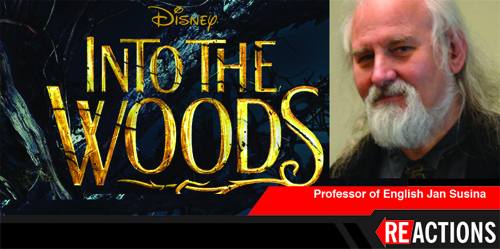The new Disney movie Into the Woods will hit theaters over the holiday season, and is already gaining award nominations. With music by Stephen Sondheim and book by James Lapine, who created the original Broadway production, the movie turns traditional fairy tales on their ears. And that is just the way it should be, says Professor of English Jan Susina, who teaches children’s literature and fairy tales.
Susina:
The movie is a strong example of the power of fairy tales – not only to hold our imagination, but also to adapt to changing times.
Into the Woods is just another contemporary reimagining of traditional fairy tales. Revisions of fairy tales are popular with TV shows like Grimm and Once Upon a Time and movies like the Shrek series. While some people might take offense that their beloved, childhood tales are stretched and transformed, they should remember that fairy tales have always been changing and shifting borders between adults and children.
Jacob and Wilhelm Grimm were scholars who feared the rise of Napoleon would mean traditional German folk tales might be lost forever. Their two-volume collection, Kinder- und Hausmärchen, (1812, 1815) was intended to preserve those folk tales that had been passed down orally for generations. And they were dark tales, full of violence and sex. Cinderella’s stepsisters slice off bits of a heel or toe in vain attempts to fit into the glass slipper. Rapunzel had twins, so you knew she and the prince had been doing more than talking in that tower hidden in the forest.
It was Edgar Taylor’s German Popular Stories (1823), the first British translation of the Grimm’s’ fairy tales, that began the continual process of revising and sanitizing the tales to make them appropriate for children. Taylor omitted the reference to Rapunzel’s twins and the heated iron slippers that are waiting for the Queen for her final dance at Snow White’s wedding. Taylor noted that he edited his translation of the Grimm tales with “the amusement of some young friends principally in mind,” meaning children.
Constant transformation is part of the nature of fairy tales. They are always in flux, constantly reflecting reshaped ideas, hopes and lessons. They are always changing over time.
Although they insisted that they faithful transcribed the tales word-for-word as they were told to them by storytellers, functioning like human tape recorders, even the Grimms made improvements and additions to many of the fairy tales in the seven editions of their collection that were published during their lifetimes.

Meryl Streep, who plays the witch in Into the Woods has already earned a Golden Globe nod for the role.
When Stephen Sondheim and James Lapine’s Into the Woods appeared on Broadway in 1987, their musical reinterpretation of fairy tales was hit. There were those who found it wrong that the duo shuffled the classic stories. In their retelling, the characters from “Cinderella,” “Little Red Riding Hood,” “Jack and the Beanstalk,” and “Rapunzel” interweave with new characters – a baker and his wife. In Act 1 of Into the Woods, all the characters make a wish, which comes true. But cleverly in Act 2, Sondheim and Lapine shows the audience what happens after “Happily Ever After,” and it is not all happy, including infidelity and several deaths. Into the Woods reminds us that you must be careful what you wish for.
It is ironic, but now that Disney has adapted Sondheim’s adult musical into a children’s film, some people are concerned that film will clean up too many of the darker aspects of the fairy tales. Sondheim and Lapine wrote the script and music for the film, but acknowledged there are parts of the musical that Disney has toned down to make it more family fare.
The director, Rob Marshall has also directed the film adaptations of the musicals Chicago and Nine. Marshall said he wanted to make Into the Woods because it is a fairy tale for the post 9-11 generation – something perhaps less sugarcoated than versions of fairy tales of our youth. This speaks to the resilience of fairy tales. They still entertain, whether remade for children, teens or adults.
There are hundred of versions of “Little Red Riding Hood” told all over the world. “Cinderella” is the world’s most popular fairy tale and there are probably thousand variations. Disney’s Frozen is an imaginative reworking of H. C. Andersen’s “The Snow Queen” that resonates with contemporary children. Every fairy tale will have something different that makes it relevant to those who hear it. Fairy tales change. That is what we do to them.
No one can say what is the “right’ version of a fairy tale. There are plenty of versions of fairy tales out there for everyone.
Susina can be contacted via MediaRelations@IllinoisState.edu.

